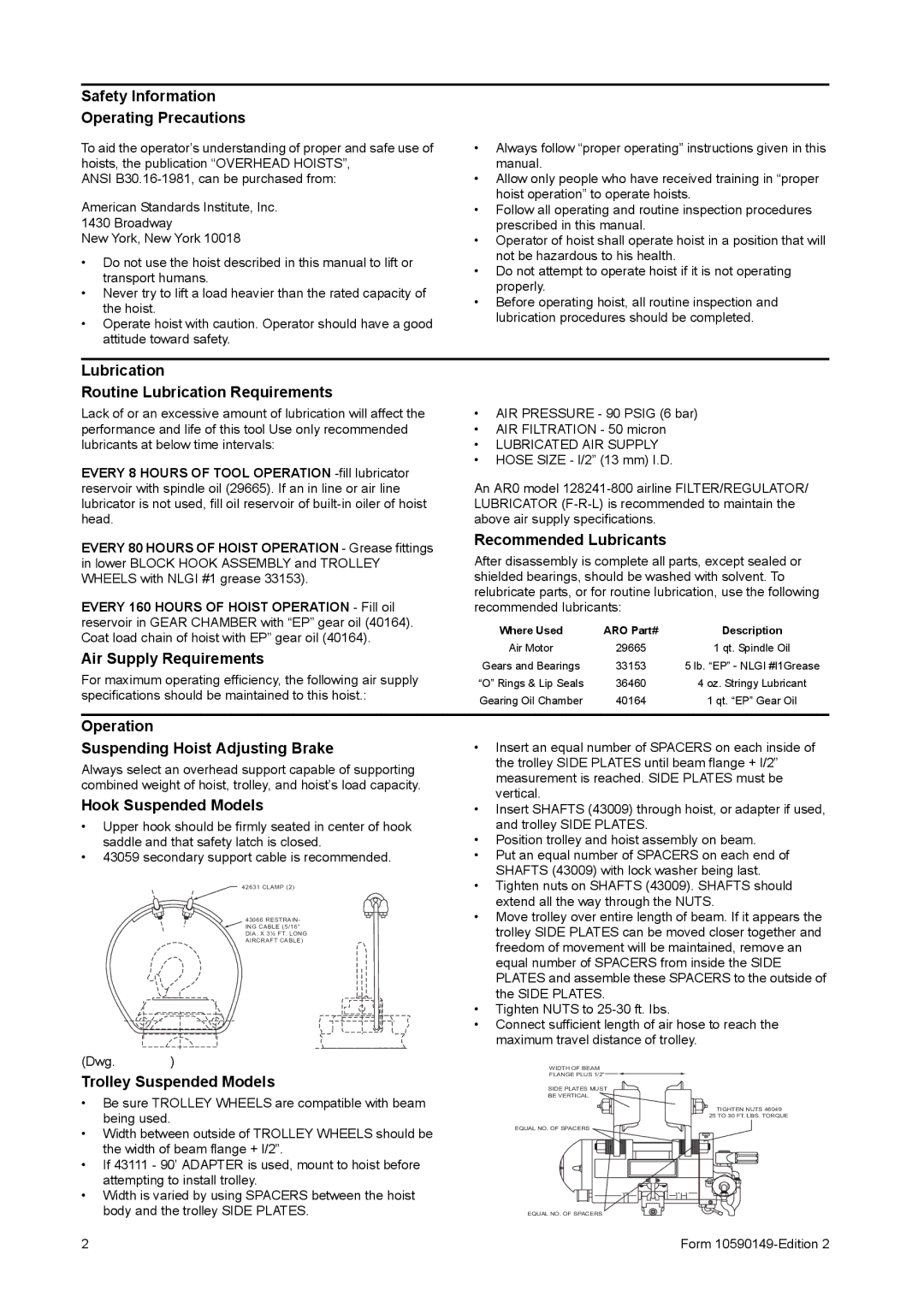
Safety Information
Operating Precautions
To aid the operator’s understanding of proper and safe use of hoists, the publication “OVERHEAD HOISTS”,
ANSI
American Standards Institute, Inc.
1430 Broadway
New York, New York 10018
•Do not use the hoist described in this manual to lift or transport humans.
•Never try to lift a load heavier than the rated capacity of the hoist.
•Operate hoist with caution. Operator should have a good attitude toward safety.
•Always follow “proper operating” instructions given in this manual.
•Allow only people who have received training in “proper hoist operation” to operate hoists.
•Follow all operating and routine inspection procedures prescribed in this manual.
•Operator of hoist shall operate hoist in a position that will not be hazardous to his health.
•Do not attempt to operate hoist if it is not operating properly.
•Before operating hoist, all routine inspection and lubrication procedures should be completed.
Lubrication
Routine Lubrication Requirements
Lack of or an excessive amount of lubrication will affect the performance and life of this tool Use only recommended lubricants at below time intervals:
EVERY 8 HOURS OF TOOL OPERATION
EVERY 80 HOURS OF HOIST OPERATION - Grease fittings in lower BLOCK HOOK ASSEMBLY and TROLLEY WHEELS with NLGI #1 grease 33153).
EVERY 160 HOURS OF HOIST OPERATION - Fill oil reservoir in GEAR CHAMBER with “EP” gear oil (40164). Coat load chain of hoist with EP” gear oil (40164).
Air Supply Requirements
For maximum operating efficiency, the following air supply specifications should be maintained to this hoist.:
•AIR PRESSURE - 90 PSIG (6 bar)
•AIR FILTRATION - 50 micron
•LUBRICATED AIR SUPPLY
•HOSE SIZE - l/2” (13 mm) I.D.
An AR0 model
Recommended Lubricants
After disassembly is complete all parts, except sealed or shielded bearings, should be washed with solvent. To relubricate parts, or for routine lubrication, use the following recommended lubricants:
Where Used | ARO Part# | Description |
Air Motor | 29665 | 1 qt. Spindle Oil |
Gears and Bearings | 33153 | 5 lb. “EP” - NLGI #l1Grease |
“O” Rings & Lip Seals | 36460 | 4 oz. Stringy Lubricant |
Gearing Oil Chamber | 40164 | 1 qt. “EP” Gear Oil |
Operation
Suspending Hoist Adjusting Brake
Always select an overhead support capable of supporting combined weight of hoist, trolley, and hoist’s load capacity.
Hook Suspended Models
•Upper hook should be firmly seated in center of hook saddle and that safety latch is closed.
•43059 secondary support cable is recommended.
42631 CLAMP (2)
43066 RESTRAIN- ING CABLE (5/16” DIA. X 3½ FT. LONG AIRCRAFT CABLE)
(Dwg. )
Trolley Suspended Models
•Be sure TROLLEY WHEELS are compatible with beam being used.
•Width between outside of TROLLEY WHEELS should be the width of beam flange + l/2”.
•If 43111 - 90’ ADAPTER is used, mount to hoist before attempting to install trolley.
•Width is varied by using SPACERS between the hoist body and the trolley SIDE PLATES.
•Insert an equal number of SPACERS on each inside of the trolley SIDE PLATES until beam flange + l/2” measurement is reached. SIDE PLATES must be vertical.
•Insert SHAFTS (43009) through hoist, or adapter if used, and trolley SIDE PLATES.
•Position trolley and hoist assembly on beam.
•Put an equal number of SPACERS on each end of SHAFTS (43009) with lock washer being last.
•Tighten nuts on SHAFTS (43009). SHAFTS should extend all the way through the NUTS.
•Move trolley over entire length of beam. If it appears the trolley SIDE PLATES can be moved closer together and freedom of movement will be maintained, remove an equal number of SPACERS from inside the SIDE PLATES and assemble these SPACERS to the outside of the SIDE PLATES.
•Tighten NUTS to
•Connect sufficient length of air hose to reach the maximum travel distance of trolley.
WIDTH OF BEAM
FLANGE PLUS 1/2”
SIDE PLATES MUST
BE VERTICAL
TIGHTEN NUTS 46049
25 TO 30 FT. LBS. TORQUE
EQUAL NO. OF SPACERS
EQUAL NO. OF SPACERS
2 | Form |
